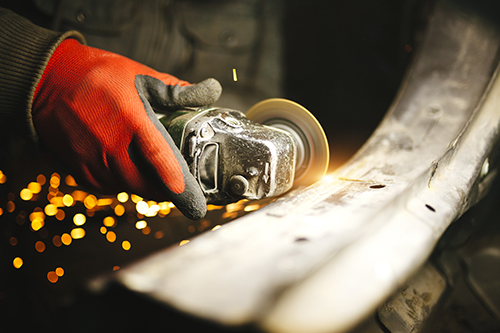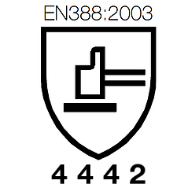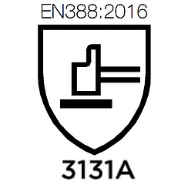What is EN 388?
15 October 2018 | Eugene
When it comes to protecting your hands at work, you need to make sure the equipment you use is tried and tested to make sure it will get the job done. To take the guesswork out of the process, there are a number of different European standards that gloves need to be certified with in order to be legally sold in Europe. One of the most important of these is EN 388 – a standard governing the protection your gloves provide from mechanical risks (cut, tears, punctures and abrasion). These standards are regularly updated, so to keep you up to date, this short article will go over the new EN 388:2016 certification and how it's changed.

EN 388:2016 is designed to give a more comprehensive picture of a glove's mechanical resistance
Why the Change?
The original EN 388:2003 certification was considered comprehensive when it was implemented, but after more than a decade, glove manufacturing had advanced to a point where it was no longer sufficient. Newer protective gloves often include steel and glass fibres to provide higher levels of resistance, and these fibres are known to dull the circular blades used in the testing process. This new obstacle to the testing process means that EN 388:2003 no longer provides a full picture of the protection a glove can provide. With new testing methods, we can now provide a more comprehensive measure of cut resistance with the addition of the ISO 13997 cut resistance test, which we'll elaborate on below.
EN 388:2003 Certification
Under EN 388:2003, gloves were rated for their resistance to abrasion, cut, tear and puncture. The level of resistance provided against each of these hazards was indexed below the EN 388 symbol. The resistance ratings were listed from left to right in the order of abrasion; cut; tear; and puncture, with resistance represented by a rating from 1 (minimal protection) to 5 (the highest rating awarded). The old resistance standard was represented by this symbol:

A glove bearing this marking would have received resistance ratings of:
| Mechanical Hazard | EN 388 Rating |
| Abrasion | Level 4 |
| Cut | Level 4 |
| Tear | Level 4 |
| Puncture | Level 2 |
How Is EN 388:2016 Different?
With the revision to the standards of EN 388, more rigorous cut and abrasion testing is carried out, as well as impact testing (where applicable). Here's what you need to know about these changes:
Cut Resistance Testing
One of the major changes under EN 388:2016 is that gloves now receive ratings for their resistance to both straight and circular blade cut. This means that the EN 388:2016 marking carries two different cut ratings. The first rating is for circular cut, as it was before, but there is now the addition of the ISO 13997 cut resistance test, which is listed as EN ISO Cut on our website's mechanical resistance charts.
EN ISO 13997 Cut Test
As we mentioned in the beginning of this article, the previous cut test, or 'Coup Test', tended to suffer in validity as steel or glass-infused fibres would dull a circular testing blade over time. Under the new test, a straight blade is drawn across the glove at a constant speed and force, and is replaced after each cutting cycle to ensure dulling does not take place. The sample is cut give times with three different force loads, after which the glove is given an EN ISO Cut rating between A and F.
Abrasion Resistance Testing
EN 388:2016 isn't just becoming more comprehensive in terms of cut resistance – it's receiving an upgrade to the way it grades abrasion resistance as well. Under the new testing method, a new abrasive test paper is being used, which will then be rubbed against a section of fabric cut from the palm of the glove. The test is completed once a hole appears in the fabric, at which point a score from 1 - 4 will be given. Since a newer version of the testing paper is now being used, some abrasion scores may differ from the EN 388:2003 rating.
Impact Protection Testing
Where applicable, a rating for impact protection is now included under EN 388:2016. This means that if a glove claims impact resistant properties, it will be tested to ensure the validity of this claim. This will be represented by a "P" marking after the EN ISO Cut marking we've shown in the marking graphic below.
Updated EN 388:2016 Markings
The new order of performance rating (from left to right) is abrasion; circular blade cut; tear; puncture; and straight blade cut (EN ISO cut), which is sometimes followed by an impact rating. The new rating received for cut resistance is classified using the letters A to F, with "F" being the highest level, and "A" being the lowest. If a glove provides protection against impact, this will be denoted with a sixth symbol – a "P" – underneath the EN 388:2016 marking. Here's an example of the EN 388:2016 marking:

This glove would be classified as:
| Mechanical Hazard | EN 388 Rating |
| Abrasion | Level 3 |
| Cut | Level 1 |
| Tear | Level 3 |
| Puncture | Level 1 |
| EN ISO Cut | A |
Constant Innovation
At WorkWear.co.uk, we're committed to providing the latest in protective glove technology, as well as the knowledge to back up our products. The world of gloves in constantly changing, so this will surely not be the last time that our mechanical resistance standards are updated, and we look forward to the next innovation. If you have any questions about our gloves and how they have performed on EN 388 tests, don't hesitate to contact our Customer Care Team at 020 7501 0598, or leave us a question in the comments section below.